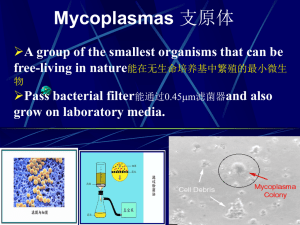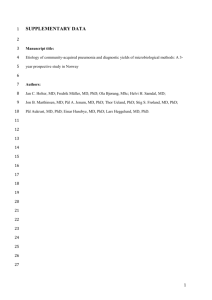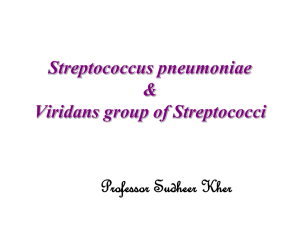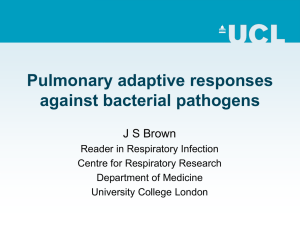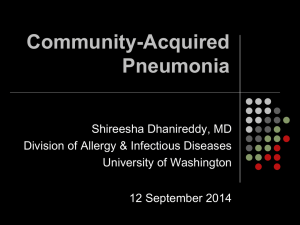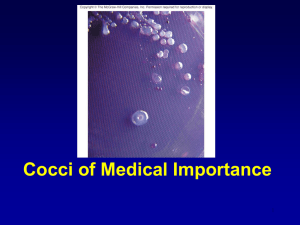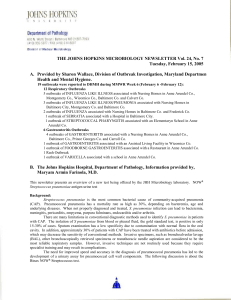file - BioMed Central
advertisement
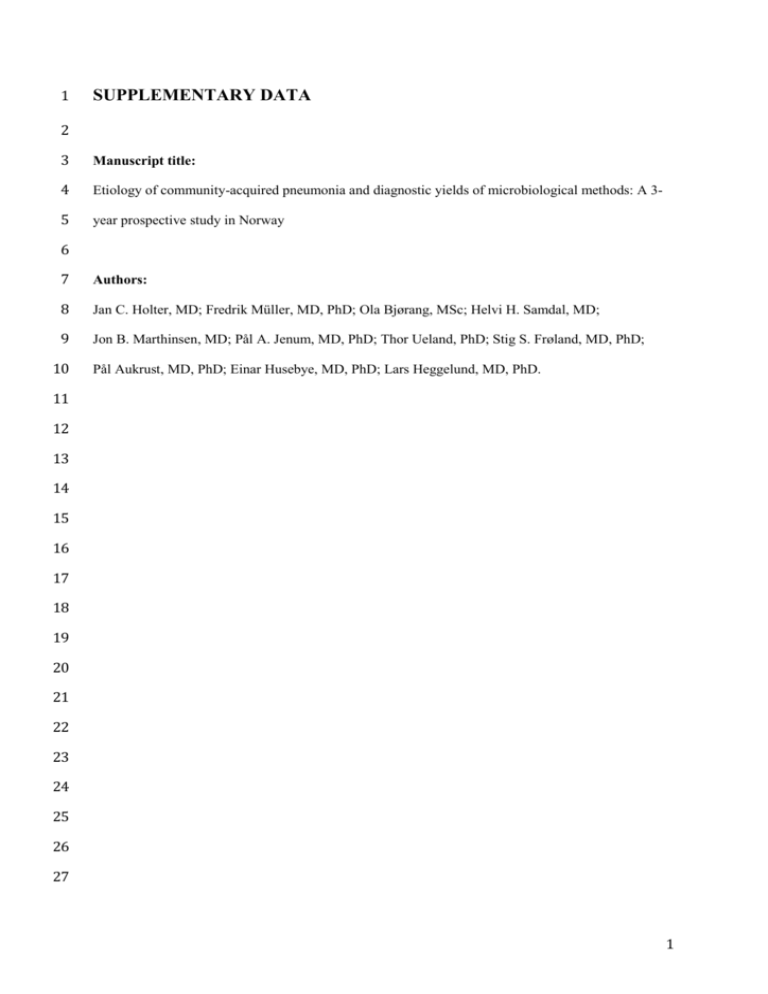
1 SUPPLEMENTARY DATA 2 3 Manuscript title: 4 Etiology of community-acquired pneumonia and diagnostic yields of microbiological methods: A 3- 5 year prospective study in Norway 6 7 Authors: 8 Jan C. Holter, MD; Fredrik Müller, MD, PhD; Ola Bjørang, MSc; Helvi H. Samdal, MD; 9 Jon B. Marthinsen, MD; Pål A. Jenum, MD, PhD; Thor Ueland, PhD; Stig S. Frøland, MD, PhD; 10 Pål Aukrust, MD, PhD; Einar Husebye, MD, PhD; Lars Heggelund, MD, PhD. 11 12 13 14 15 16 17 18 19 20 21 22 23 24 25 26 27 1 28 Methods 29 Details of serological methods 30 Complement fixation test (CFT) was performed for determination of complement-fixing antibodies 31 against influenza A and B viruses (SERION CFT reagents, Institut Virion\Serion GmbH); and a 32 qualitative and quantitative enzyme-linked immunosorbent assay (SERION ELISA classic Bordetella 33 pertussis Toxin IgA and IgG test) was used for the detection of B. pertussis toxin (PT-IgG). If paired 34 samples were available, serologic testing for M. pneumoniae and C. pneumoniae were performed by 35 CFT (SERION CFT reagents, Institut Virion\Serion GmbH), otherwise by immunoassays for IgM 36 detection (NOVITEC Mycoplasma and NOVITEC Chlamydia pneumoniae; HiSS Diagnostics, 37 Freiburg, Germany) on acute- or convalescent-phase sample. The ELISA tests were performed on 38 Best 2000/1DXC-1267. All paired samples were run in parallel using same lots and plates. 39 Details of real-time PCR methods and pneumococcal qPCR assay 40 Single-agent assays were performed consecutively by real-time PCR for detection of M. pneumoniae 41 (ABI 7500 Fast, Applied Biosystems®, Rotkreuz, Switzerland); primers 42 TTCTTCAGGCTCAGGTCAATCTG and CCGTCACTCGTGCTTGGTA, TaqMan-probe FAM- 43 ACTGCCCCACAAGCC (targeting the P1 adhesin gene); and for detection of C. pneumoniae [1], B. 44 pertussis [2], L. pneumophila [3] and P. jirovecii [4] using LightCycler 2.0® (Roche Diagnostics, 45 Basel, Switzerland). 46 Detection of S. pneumoniae and respiratory viruses were performed retrospectively. For 47 detection and quantification of S. pneumoniae, we used primers specific for ply gene, probe sequences 48 and TaqMan assay as described by Greiner et al [5]. Primers were obtained from Invitrogen (Life 49 TechnologiesTM, US) and TaqMan probes from TIB MolBiol (TIB MolBiol, Berlin, Germany). With 50 regard to respiratory viruses, four reactions were in-house multiplex real-time RT-PCR assays; 51 influenza A [6] and B [7] viruses; parainfluenza viruses types 1 [8], 2 and 3 [9]; metapneumovirus 52 [10] and rhinovirus [11]; and enterovirus [12] and respiratory syncytial virus (A and B) [13]. The 53 other reactions were performed as in-house single assays; H1N1 real-time RT-PCR on influenza A 54 virus positive samples [14]; and real-time PCR for the detection of adenovirus [15]. In each reaction 2 55 Rnase P [6] was included as an internal control. In brief, automated genomic RNA and DNA 56 extraction was performed with MagNa pure LC using the total nucleic acid isolation kit system 57 according to the manufacturer’s protocol (Roche Diagnostics), cDNA was synthesized by using 58 qScriptTM cDNA SuperMix (Quanta Biosciences). The real-time PCRs were carried out on the 59 LightCycler®480II (Roche Diagnostics). 60 Determination of the detection range of the pneumococcal qPCR assay and the cut-off 61 quantification cycle (Cq) value corresponding to 105 cfu/mL 62 To determine the detection range of the qPCR assay and to assess the corresponding Cq value, a 63 standard curve for S. pneumoniae was generated as follows: The S. pneumoniae reference strain 64 ATCC 49619 was inoculated onto horse blood agar and incubated at 37°C in aerobic atmosphere with 65 5% CO2 for 24 h. Bacteria were suspended in physiological saline at a density of 0.5 McFarland 66 (Vitek Densichek, Biomerieux), representing approximately 108 cfu/mL and 10-fold serial dilutions in 67 physiological saline were prepared. The number of colony-forming units was determined by plating 68 10 μL and 100 μL of each dilution onto the agar plates with aerobic incubation overnight at 37°C. 69 Two hundred μL of each dilution was used for DNA extraction and analyzed by qPCR in triplicates. 70 The cut-off value of 105 cfu/mL was derived from studies of quantitative sputum cultures related to 71 blood culture results [16], in agreement with validation—and clinical—studies using the ply gene 72 [17,18]. 105 cfu/mL corresponded to a Cq value of 28.05, and this Cq value was applied as a cut-off 73 value for the clinical samples. 74 Accuracy of the pneumococcal qPCR assay 75 In the absence of a sensitive reference standard, the accuracy of the ply qPCR assay to distinguish 76 between pneumococcal and non-pneumococcal etiology in patients with CAP were calculated using a 77 pooled diagnostic standard for pneumococcal pneumonia (i.e., demonstration of pneumococci by any 78 conventional method; blood culture, pleural fluid culture, urinary antigen assay, sputum or NP 79 culture). ROC analysis (not shown) showed good diagnostic accuracy for NP sampling (AUC, 0.80 80 95%CI [0.72–0.87]) and fair diagnostic accuracy for OP sampling (AUC, 0.74 [0.66–0.82]). The use 81 of pneumococcal DNA Cq cut-off corresponding to ≥105 cfu/mL resulted in higher sensitivity and 82 lower specificity for OP sampling (sensitivity 31.5%, specificity 90.2%) than for NP sampling 3 83 (18.5%, 96.8%). 84 85 86 87 88 89 90 91 92 93 94 95 96 97 98 99 100 101 102 103 104 105 106 107 108 109 110 111 112 113 114 Supplementary Table 1 Single and multiple bacterial and viral agents detected in 167 adults with an etiologically 115 established diagnosis of community-acquired pneumonia 4 Pure bacterial and pure viral infections n (%) Viral–bacterial coinfections n (%) Pure bacterial (single) 60 (36) Viral–bacterial (dual) 36 (22) S. pneumoniae 37 (22) S. pneumoniae plus: M. pneumoniae 7 (4) Influenza viruses 13 (8) C. pneumoniae 5 (3) Rhinovirus 8 (5) H. influenzae 2 (1) Metapneumovirus 2 (1) M. catarrhalis 2 (1) Parainfluenza viruses 1 (0.6) L. pneumophila 2 (1) Respiratory syncytial virus 1 (0.6) B. pertussis 2 (1) H. influenzae plus: Group A streptococcus 1 (0.6) Parainfluenza viruses H. parainfluenzae 1 (0.6) Influenza viruses 1 (0.6) Enterobacteriaceae 1 (0.6) Metapneumovirus 1 (0.6) Pure viral (single) 38 (23) Rhinovirus 1 (0.6) Influenza virusesa 15 (9) Rhinovirus 12 (7) Influenza viruses Metapneumovirus 3 (2) Respiratory syncytial virus Parainfluenza viruses 3 (2) M. catarrhalis plus: Respiratory syncytial virus 3 (2) Influenza viruses Enterovirus 2 (1) Adenovirus 0 (0) Pure bacterial (dual) 15 (9) S. pneumoniae plus: H. influenzae 2 (1) B. pertussis plus: 3 (2) 1 (0.6) 1 (0.6) Enterobacteriaceae plus: Rhinovirus Viral–bacterial (multiple) 1 (0.6) 15 (9) S. pneumoniae plus: 4 (2) M. catarrhalis and rhinovirus 2 (1) Enterobacteriaceae 1 (0.6) H. influenzae and enterovirus 1 (0.6) L. pneumophila 1 (0.6) Group A streptococcus and influenza viruses 1 (0.6) M. pneumoniae 1 (0.6) B. pertussis and influenza viruses 1 (0.6) B. pertussis 1 (0.6) B. pertussis and rhinovirus 1 (0.6) C. pneumoniae and parainfluenza viruses 1 (0.6) Influenza viruses and rhinovirus 1 (0.6) Parainfluenza viruses and adenovirus 1 (0.6) L. pneumophila plus: B. pertussis 2 (1) Enterobacteriaceae plus: M. pneumoniae 1 (0.6) Metapneumovirus and rhinovirus 1 (0.6) C. pneumoniae 1 (0.6) Rhinovirus and enterovirus 1 (0.6) H. influenzae plus: H. parainfluenzae L. pneumophila plus: 1 (0.6) M. pneumoniae plus: B. pertussis 1 (0.6) B. pertussis and influenza viruses 1 (0.6) B. pertussis and rhinovirus 1 (0.6) H. influenzae plus: 5 D. pneumosintes plus: B. pertussis and rhinovirus Prevotella spp. 1 (0.6) Pure viral (dual) 3 (2) Influenza viruses plus: 1 (0.6) Enterobacteriaceae plus: Influenza viruses and enterovirus 1 (0.6) … … Rhinovirus 1 (0.6) … … Respiratory syncytial virus 1 (0.6) … … … … … … Rhinovirus plus: Respiratory syncytial virus 1 (0.6) 116 Note: S. pneumoniae, Streptococcus pneumoniae; M. pneumoniae, Mycoplasma pneumoniae; C. pneumoniae, 117 Chlamydophila pneumoniae; H. influenzae, Haemophilus influenzae; M. catarrhalis, Moraxella catarrhalis; L. 118 pneumophila, Legionella pneumophila; B. pertussis, Bordetella pertussis; H. parainfluenzae, Haemophilus parainfluenzae; 119 D. pneumosintes, Dialister pneumosintes. 120 a One patient was also coinfected with Pneumocystis jirovecii. 121 122 6 123 Supplementary Table 2 Pairwise comparison of diagnostic yields between different techniques used for the detection of respiratory pathogens in patients with community-acquired 124 pneumonia Pathogen Detection rate, % (No. positive/No. of cases with valid tests) P Agreement, % Kappa .52 69.9 NC .10 85.9 0.23 .51 87.7 0.12 1.00 91.1 0.20 .07 87.9 0.37 .31 90.0 0.32 14.8 (35/237) .07 81.9 0.15 Urinary antigen Blood culture Sputum culture NP swab culture 20.5 (15/73) 15.1 (11/73) NP swab PCR OP swab PCR Serology test Bacteriaa S. pneumoniae 8.0 (21/262) 12.2 (32/262) S. pneumoniae 5.5 (4/73) S. pneumoniae 5.9 (4/68) S. pneumoniae 6.1 (4/66) 9.6 (7/73) 5.9 (4/68) 15.2 (10/66) S. pneumoniae 9.2 (22/239) S. pneumoniae 9.3 (22/237) 6.7 (16/239) S. pneumoniae 6.0 (14/235) 14.5 (34/235) < .001 87.2 0.32 M. pneumoniae 2.7 (7/259) 2.3 (6/259) 1.00 98.8 0.76 M. pneumoniae 2.3 (6/256) 1.2 (3/256) .38 98.0 0.44 1.2 (3/256) .38 98.0 0.44 .56 99.2 NC 2.3 (6/256) .06 97.7 NC 2.3 (6/256) .22 97.7 0.24 NC 100.0 NC 5.1 (13/256) .001 94.9 NC 5.1 (13/256) .001 94.9 NC .84 89.7 0.72 M. pneumoniae 2.3 (6/256) C. pneumoniae 0.0 (0/259) C. pneumoniae 0.0 (0/256) C. pneumoniae 0.8 (2/256) B. pertussis 0.0 (0/259) B. pertussis 0.0 (0/256) B. pertussis Respiratory virusesb 0.8 (2/259) 0.0 (0/259) 0.0 (0/256) 23.5 (55/234) 24.4 (57/234) 7 Influenza viruses 6.0 (14/234) Influenza virusesc 6.4 (15/236) Influenza virusesd 6.4 (15/234) 6.4 (15/235) 1.00 97.9 0.82 14.4 (34/236) < .001 89.4 0.44 14.5 (34/235) < .001 90.2 0.49 125 Note: Missing data were excluded from the analysis. S. pneumoniae was detected by use of qPCR; and M. pneumoniae, C. pneumoniae, B. pertussis and respiratory viruses by use of real-time 126 PCR. NC, not calculated; S. pneumoniae, Streptococcus pneumoniae; M. pneumoniae, Mycoplasma pneumoniae; C. pneumoniae, Chlamydophila pneumoniae; B. pertussis, Bordetella 127 pertussis; NP, nasopharynx; OP, oropharynx; PCR, polymerase chain reaction; qPCR, real-time quantitative PCR. 128 a Any bacteria growth. 129 b Any of the following: influenza viruses, rhinovirus, parainfluenza viruses, respiratory syncytial virus, metapneumovirus, enterovirus or adenovirus. 130 c If only seropositive–high titer tests were included, the numbers were: 6.4 (15/236) vs. 5.1 (12/236), P = .69, Agreement 89%, Kappa 0.02. 131 d If only seropositive–high titer tests were included, the numbers were: 6.4 (15/235) vs. 5.1 (12/235), P = .66, Agreement 91%, Kappa 0.18. 132 133 134 135 136 137 138 139 140 141 8 S. pneumoniae and influenza viruses 100 90 2008 2009 Case positive (%) 80 2010 S. pneumoniae 70 Influenza viruses 60 50 40 30 20 10 0 W Sp Su F W Sp Su F W Sp Su F W Season 142 143 Supplementary figure 1 Seasonal distribution of CAP patients with influenza viruses and S. 144 pneumoniae during a 3-year study period. A total of 266 patients were tested for influenza A and B 145 viruses by at least one method (PCR and/or serology). In Norway, the first 2 cases of 2009 pandemic 146 influenza A (H1N1) virus infection were reported on May 9. The number of reported cases reached a 147 peak in November and declined until December before WHO, on August 10, 2010, announced that 148 the H1N1 pandemic had moved into the post-pandemic period. Only 2 cases of influenza A (H1N1) 149 virus infection were detected in our hospital during the study period (not shown). 150 The 7-valent pneumococcal conjugate vaccine was introduced in the childhood immunization 151 program in 2006. Due to herd effect, a decrease in the overall invasive pneumococcal incidence was 152 observed among the elderly in Norway (> 50 years of age) until 2009, and was relatively stable 153 through the remainder of the study period [19]. Thus, a reduction in our data during this period was 154 not expected (a total of 267 patients were tested by at least one detection method for S. pneumoniae). 155 Detection rates of influenza viruses and S. pneumoniae among hospitalized adult CAP 9 156 patients appeared to follow normal seasonal variation with peaks in the cold seasons. S. pneumoniae, 157 Streptococcus pneumoniae. 158 159 References 160 1. Mygind T, Birkelund S, Falk E, Christiansen G: Evaluation of real-time quantitative PCR 161 for identification and quantification of Chlamydia pneumoniae by comparison with 162 immunohistochemistry. J Microbiol Methods 2001, 46(3):241-251. 163 2. Kosters K, Reischl U, Schmetz J, Riffelmann M, Wirsing von Konig CH: Real-time 164 LightCycler PCR for detection and discrimination of Bordetella pertussis and 165 Bordetella parapertussis. J Clin Microbiol 2002, 40(5):1719-1722. 166 3. Reischl U, Linde HJ, Lehn N, Landt O, Barratt K, Wellinghausen N: Direct detection and 167 differentiation of Legionella spp. and Legionella pneumophila in clinical specimens by 168 dual-color real-time PCR and melting curve analysis. J Clin Microbiol 2002, 40(10):3814- 169 3817. 170 4. Larsen HH, Masur H, Kovacs JA, Gill VJ, Silcott VA, Kogulan P, Maenza J, Smith M, Lucey 171 DR, Fischer SH: Development and evaluation of a quantitative, touch-down, real-time 172 PCR assay for diagnosing Pneumocystis carinii pneumonia. J Clin Microbiol 2002, 173 40(2):490-494. 174 5. Greiner O, Day PJ, Bosshard PP, Imeri F, Altwegg M, Nadal D: Quantitative detection of 175 Streptococcus pneumoniae in nasopharyngeal secretions by real-time PCR. J Clin 176 Microbiol 2001, 39(9):3129-3134. 177 6. WHO collaborating Centre for Influenza at CDC (2009) CDC protocol of real-time 178 RTPCR for influenza A (H1N1) 179 [http://www.who.int/csr/resources/publications/swineflu/CDCRealtimeRTPCR_SwineH1Ass 180 ay-2009_20090430.pdf] 10 181 7. Ward CL, Dempsey MH, Ring CJ, Kempson RE, Zhang L, Gor D, Snowden BW, Tisdale M: 182 Design and performance testing of quantitative real time PCR assays for influenza A 183 and B viral load measurement. J Clin Virol 2004, 29(3):179-188. 184 8. Watzinger F, Suda M, Preuner S, Baumgartinger R, Ebner K, Baskova L, Niesters HG, 185 Lawitschka A, Lion T: Real-time quantitative PCR assays for detection and monitoring 186 of pathogenic human viruses in immunosuppressed pediatric patients. J Clin Microbiol 187 2004, 42(11):5189-5198. 188 9. Echevarria JE, Erdman DD, Swierkosz EM, Holloway BP, Anderson LJ: Simultaneous 189 detection and identification of human parainfluenza viruses 1, 2, and 3 from clinical 190 samples by multiplex PCR. J Clin Microbiol 1998, 36(5):1388-1391. 191 10. Maertzdorf J, Wang CK, Brown JB, Quinto JD, Chu M, de Graaf M, van den Hoogen BG, 192 Spaete R, Osterhaus AD, Fouchier RA: Real-time reverse transcriptase PCR assay for 193 detection of human metapneumoviruses from all known genetic lineages. J Clin 194 Microbiol 2004, 42(3):981-986. 195 11. Deffernez C, Wunderli W, Thomas Y, Yerly S, Perrin L, Kaiser L: Amplicon sequencing 196 and improved detection of human rhinovirus in respiratory samples. J Clin Microbiol 197 2004, 42(7):3212-3218. 198 12. Glimaker M, Johansson B, Olcen P, Ehrnst A, Forsgren M: Detection of enteroviral RNA 199 by polymerase chain reaction in cerebrospinal fluid from patients with aseptic 200 meningitis. Scand J Infect Dis 1993, 25(5):547-557. 201 13. 202 203 Brittain-Long R, Nord S, Olofsson S, Westin J, Anderson LM, Lindh M: Multiplex real-time PCR for detection of respiratory tract infections. J Clin Virol 2008, 41(1):53-56. 14. Robert Koch Institut. TaqMan real-time PCR zur Detektion von porcinen Influenza 204 A/H1N1-Viren [http:/http://www.rki.de/cln 179/nn 205 200120/DE/Content/InfAZ/I/Influenza/IPV/Schweinegrippe PCR.html] 206 207 15. Heim A, Ebnet C, Harste G, Pring-Akerblom P: Rapid and quantitative detection of human adenovirus DNA by real-time PCR. J Med Virol 2003, 70(2):228-239. 11 208 16. Kalin M, Lindberg AA: Diagnosis of pneumococcal pneumonia: a comparison between 209 microscopic examination of expectorate, antigen detection and cultural procedures. 210 Scand J Infect Dis 1983, 15(3):247-255. 211 17. Kais M, Spindler C, Kalin M, Ortqvist A, Giske CG: Quantitative detection of 212 Streptococcus pneumoniae, Haemophilus influenzae, and Moraxella catarrhalis in lower 213 respiratory tract samples by real-time PCR. Diagn Microbiol Infect Dis 2006, 55(3):169- 214 178. 215 18. Johansson N, Kalin M, Tiveljung-Lindell A, Giske CG, Hedlund J: Etiology of community- 216 acquired pneumonia: increased microbiological yield with new diagnostic methods. Clin 217 Infect Dis 2010, 50(2):202-209. 218 19. Steens A, Bergsaker MA, Aaberge IS, Ronning K, Vestrheim DF: Prompt effect of 219 replacing the 7-valent pneumococcal conjugate vaccine with the 13-valent vaccine on the 220 epidemiology of invasive pneumococcal disease in Norway. Vaccine 2013, 31(52):6232- 221 6238. 222 223 224 12
